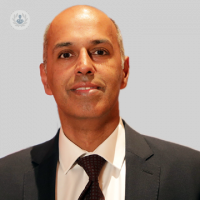Wiggle the way out of uncomfortable varicose vein symptoms with expert treatment
Written by:
Varicose veins are noted for the way they look but what about other associated symptoms? They can be uncomfortable, itchy and painful.
Here to highlight the condition and explain how treatment can be tailored to each individual patient, is leading consultant vascular surgeon Mr Manj Gohel.

What exactly are varicose veins and what are the main causes?
Varicose veins are bulgy, wiggly, distended veins that appear, usually on the lower part of the legs, or sometimes the thighs, and people often find them very unsightly.
They're extremely common, and usually it's a result of the veins not flowing in the correct direction. The blood should flow up the leg towards the heart, but if the veins are faulty then the blood flows down the leg, and this can lead to these bulgy, unsightly and often painful veins.
So, varicose veins are very common. Around a quarter of adults have varicose veins, and sometimes they don't cause any symptoms but often they can be a really significant cause of distress, but also complications and problems.
If left untreated, what can varicose veins lead to?
Many patients with varicose veins don't have any symptoms, and I certainly meet lots of patients who've had varicose veins for many years or decades without a problem. However, the older you get, with longstanding varicose veins, they can cause a number of complications.
The veins can cause symptoms including:
- Itching
- Aching
- Heaviness
- Burning
Blood clots can form within the veins which is called superficial vein thrombosis, or thrombophlebitis, and this is a relatively common problem.
The skin in the lower part of the leg can become discoloured and quite itchy with eczema, and really as a more advanced and extreme presentation, we do see patients with varicose veins who've developed ulcers on their legs. Now, ulcers are wounds on the legs, or open sores, that can be very painful, smelly and distressing. So, not everyone develops these complications but it's certainly a very common part of my practice. I see a lot patients with these sorts of problems.
What are the main symptoms of varicose veins?
The most common symptoms are aching, heaviness and itchiness over the veins. Actually, swelling of the lower leg is something that people often report. A little bit of swelling is quite common, particularly if people spend a lot of time on their feet, but this can be much worse in people with varicose veins.
The swelling often occurs towards the end of the day. But sometimes it can occur all the time and actually patients often wake up first thing in the morning with really quite swollen and painful legs. These are the common symptoms and with more advanced problems, skin discolouration and other complications such as ulcers can also form.
What are the main treatment options for varicose veins?
In the last 15 or so years, there's been a really dramatic advance in the treatment available for varicose veins. Traditionally we used to strip the veins out of the leg, which was a fairly major operation under general anaesthetic and associated with significant complications including blood clots and bruising.
We've seen a really impressive range of keyhole techniques that are now available, and most varicose vein operations can be performed using a keyhole technique. The most common of these are what we call 'thermal techniques', so laser or radiofrequency ablation.
These are techniques to seal off the vein and to stop it feeding the large varicose veins. We also have novel techniques such as glue; a superglue technique to seal off the veins, and other techniques such as foam injections which seal off the veins. Also, sometimes we do remove the very visible veins to get the best possible outcome.
The very important message is that there isn't one technique only, and actually, every single patient is unique. Every single situation is individual; and so, for each patient that's seen in the service, a unique decision-making process is followed. It's quite common for an individual patient to have a number of different techniques on the same leg, in order to get the best possible result.
Is it true that varicose veins make your legs itch? If so, how and why?
Itching is one of the very common symptoms related to varicose veins. The itching can be directly over the veins and the bulgy veins often have a feeling of burning or heat in the skin. That can be quite itchy.
Also, the long-standing presence of varicose veins can actually cause eczema in the skin of the lower part of the leg. This is an inflammatory condition in the skin, which leads to red, scaly skin and this is immensely itchy. These are the main reasons why veins can cause itching, but it's one of the most common symptoms that we see.
If you require Mr Gohel’s expertise regarding varicose veins or other vascular conditions, make an appointment with him via his Top Doctors profile


